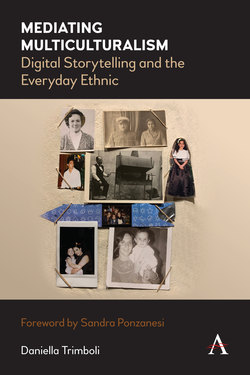Mediating Multiculturalism

Реклама. ООО «ЛитРес», ИНН: 7719571260.
Оглавление
Daniella Trimboli. Mediating Multiculturalism
Отрывок из книги
Mediating Multiculturalism
Digital Storytelling and the Everyday Ethnic
.....
Perhaps more useful for mapping today’s migrant communities is the emergent field of everyday multiculturalism, a contemporary form of critical multiculturalism that responds to the renewed demystification with multiculturalism that has surfaced in the past decade. Although the field is gaining traction across the world, it is primarily located in Western contexts, in which a perceived gap exists between how multiculturalism is managed and conceptualised and how it is actually experienced in daily life. Australian scholars, most notably, Melissa Butcher, Anita Harris, Greg Noble, Scott Poynting and Amanda Wise, are pioneering everyday multiculturalism, giving the trajectory of the field a particularly Australian orientation. However, the framework of everyday multiculturalism is being rapidly adopted in the transpacific and beyond, applied to a range of ethnographies where interculturalism, cultural diversity and social cohesion are explored. A quick glance at the preeminent book Everyday Multiculturalism by Wise and Velayutham (2009b) attests to this global adaptation: contributing authors draw on case studies from Brooklyn, London, Sydney/Eora,6 Singapore, Malaysia and Southern Italy, among others.7
The field is interested in exploring how practices of everyday life shape and reshape identities, and how this relates to the broader terrain of multiculturalism (Wise and Velayutham 2009a, p. 3). The article titled ‘Pedestrian Crossings: Young People and Everyday Multiculturalism’ in the 2010 special edition of the Journal of Intercultural Studies succinctly summarises the field as having a focus on ‘(1) everyday practices of intercultural encounter and exchange (the “doing” of multiculturalism); and (2) sites and spaces where tensions and possibilities around multicultural community and nation building occur (the places where multiculturalism is done)’ (Butcher and Harris 2010, p. 450). The need to specifically examine the everyday practices and sites of multiculturalism is linked to a feeling of disconnection between official discourse and on-the-ground experience.8 Jon Stratton (2011) illustrates how the dominant culture interprets this feeling of disconnection as a residue of migrant culture, feeling that Australian life has been undermined or overrun by non-Anglo-Celtic Australians. This sense of disconnection is also evident in the fact that racism is perpetually experienced in present-day Australia, despite Australian multiculturalism being celebrated as a national accomplishment. Recent empirical research on young people and everyday multiculturalism demonstrates this polarity. The research shows that incidents of racialised tension put a daily stress on ethnic youth, either because of mistranslations of language, fear of being harassed for dressing or looking a particular way and/or the social expulsion of ethnic youth from public areas (see Butcher and Harris 2010; Frisina 2010; Harris 2010; Noble and Poynting 2010; Rathzel 2010).
.....